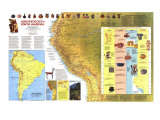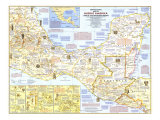* Lesson plan idea - have your students update the information and latest statistics concerning indigineous populations in the Americas; discuss the political, economic, and environmental situations that are current for the region. • maps
A Legacy of Language
New World? Hardly. Long before 16th century Europeans began to explore what would become known as North America, the land was already home to more than 30 million people by some estimates. With diverse languages and cultures they lived in thousands of communities, some established for centuries. The Pueblo peoples had constructed vast planned communities; the Maya cultivated crops with innovative farming techniques; and the Iroquois governed themselves with a six-nation democratic league. “We are a powerful confederacy,” said Iroquois leader Canassatego as he addressed an assembly of British colonists in 1744. “By your observating the same methods our wise forefathers have taken, you will acquire fresh strength and power.” Indeed. Settlers powered their way over native lands, driving most tribes to near extinction.
The tide has turned. American Indians and Alaska Natives are experiencing a cultural renaissance. They're challenging stereotypes, regaining some historically native lands, telling their stories through literature and film, and reasserting their rights to govern themselves and practice ancentral traditions. In the past decade alone, Indian casinos and other enterprises have created thousands of jobs and injected money into native schools, businesses, and health clinics.
A prominent symbol of rebirth, the National Museum of the American Indian opens this month (1972) in Washington, D.C., taking an intergral place among the pantheons of the National Mall. “Native Americans have never been more hopeful about their cultural future,” says W. Richard West, Jr., the museum's director and a member of the Cheyenne and Arapaho Tribes of Oklahoma. “That hope is grounded in a newly developed and profound sense of the worthiness of who they are.”
Indian Innovation -
Imagine our world without chocolate or chewing gum, syringes, rubber balls, or copper tubing. Native peoples invented precursors of all these and made huge strides in medicine and agriculture. They developed pain medicines, birth-control drugs, and treatment for scurvy. Their strains of domesticated corn, potatoes, and other foods helped reduce hunger and disease in Europe–though Indians also introduced the cultivation and use of tobacco. ...other notable contributions.
| PARKA- Today's ski jacket owe their origins in part to hooded coats Inuit women fashioned from layers of skins that trapped air for greater insulation. Caribou was a fur favored for its heat-holding properties |
SNOW GOGGLES - Some 2,000 years before goggles became an Alpine fashion must, the Inuit creates their own versions like one carved from walrus tusk with narrow slits to thwart snow and sea glare. |
| DUCK DECOY- Modern artisans modeled the duck of feathers and reeds on a 2,000-year-old decits iybd ub Bevada ub 1924. Archaeologists believe that early native hunters used them to lure waterfowl much as hunters use plastic decoys today |
POTTERY - Design and decoration of ceramics, even everyday cookware, reflects cultural indentity. the late Indian potter Nampeyo based their work on designs found at Sikyatki, a 14th centlry Hopi site in Arizona. Her highly acclaimed early 20th-century works revived interest in pottery creation. |
| MOCCASINS - Dyed porcupine quills adorn buckskin moccasins made by a Sioux in the 19th century. Moccasin styles were once so distinctive that they could reveal a person's tribe. (Fringe may have helped erase footprints.) Now native-inspired shoe designs can be found worldwide, from lightweight cowhide moccasins to toasty mukluks. |
FOOD - Nearly half the world's leading food crops can be traced to plants first domesticated by Indians. Native farmers introduced Europeans to a cornucopia of nutritious plants, including potatoes, peanuts, manioc, beans, tomatoes, sunflowers, and yams. Maize, or corn, was by far the most significant contribution, now grown on every continent except Antarctica. |
| BALLPLAYER - Were the Maya and Aztec sports fanatics? Having found ancient rubber balls, ceremonial courts, and depictions of ballplayers, like the Maya clay figure from Mesoamerica, archaeologists think both cultures revered certain ball games. |
|
Potent Echoes
If you say pmyim haayu, only a few souls on Earth will know you have greeted them in Kiliwa. Once spoken on the Baja peninsula, Kiliwa is now nearly extinct, as are most of the 400 or so native languages once heard across North America. Roughly half are no longer in use; only 46 are still taught to children.
The American Indian Cultures Map shows a broad sampling of linguistic families, all with languages struggling to survive. Says linguist Mauricio Mixco: “We can only wonder what disappears with each lost language–clues about human history, recipes for traditional cures, the stories of native Homers.” Time is running out to preserve these tongues before many are, as the Kiliwa would say, haat uu – gone away.
1- ESKIMO-ALEUT - Some scholars believe that this group's presence on both sides of the Bering Strait suggests that Eskimo-Aleut tribes were the last aboriginal people to migrate from Asia to North America. The local dialects of the Inuit, Inupiaq, and Uypik communities form a linguistic chain that extends from Siberia to Greenland. Native people will likely understand the dialects of neighboring villages but will struggle to communicate with those farther from home.
2- EYAK-ATHABASKAN - This language family, including Navajo, probably originated near the source of the Yukon River before spreading as far south as northern Mexico. About 140,000 people still speak Navajo, the most widely used native tongue in the U.S. Yet even with tribal efforts to increase Navajo instruction, the number of fluent children is shrinking.
3 - WAKASHAN - The first Wakashan speakers may have lived on Vancouver Island before moving northward along the British Columbian coast. The word potlatch, or feast–likely derived from Nootka–was appropriated by other tribes and English-speaking traders.
4 - SALISHAN - Scholars think tribes from the northern Pacific Coasts spread the 23 Salishan languages as they expanded along area rivers. In these languages, words may have strings of up to six consonants; some words lack vowels, other lack the consonants m and n. In Lushootseed, tacoba means “snowcapped mountains.”
5 - PLATEAU-PENUTIAN - Lewis and Clark were among the first whites to encounter some of these Northwest languages and dialects, including Nez Perce, Walla Walla, and Yakima. Now those fluent in Nez Perce number fewer than 50. The tribe has teamed up with Lewis-Clark State College to offer language courses.
6 - KIOWA-TANOAN - Although tribes in these groups share linguistic roots, their cultures stand in stark contrast. The Kiowa, a buffalo-hunting Plains people, used sign language to conduct trade with other Plains tribes. Tanoan speakers, like the Tewa, farmed, built towns, and followed Pueblo customs such as consensus building.
7 - UTO-AZTECAN - This far-flung family of more than 30 languages reached from Oregon to Nicaragua. On the 2000 U.S. census, 5,225 people claimed to speak Hopi at home. The largest language of this family, Nahuatl, was the principal tongue of the Aztec Empire. today more than a million people speak its many dialects. English has borrowed “tomato” and “coyote.”
8 - COCHIMI-YUMAN - This language family extended from the Baja peninsula into California and Arizona. The Cochimi branch is now extinct. Yuman languages sometimes bore the names of the people who spoke them, such as the Havasupai, or “people of the blue-green water.”
9 - OTOMANGUEAN - A highly diverse group of languages stretching from Mexico to Costa Rica, the Otomanguean family–like many other native languages–uses tone to change the meaning of a word, similar to Chinese.
10 - MAYAN - Among the 31 Mayan languages, Chol was the principal tongue of the Classic period (A.D. 250 to 900). Today more than two million people speak the four biggest Mayan languages: Yucatec Maya (700,000 speakers, K'iche' (675,000, Mam (400,000), and Kaqchikkel (375,000).
11 - ALGIC - Algonquin, the biggest branch of this family, has given English many nouns, including “toboggan,” “hickory,” “chipmunk,” and “caucus.” In 1663 the first Bible printed in the Western Hemisphere was published in the Algic Massachusett language. Cree and Ojibwa are still widely spoken in native communities in Canada and the U.S. Most Algic speakers lived east of the Rockies, but linguists have found two isolated Algic languages in California: Wiyot and Yurok.
12 - SIOUAN-CATAWBA - Some of the last words Custer heard before he died at Little Bighorn may have been spoken in Lakota, the language of the Sioux Nation and the source of the word tipi. Research suggests this group emerged in the Ohio Valley as early as 4000 B.C. Today KILI radio broadcasts a range of programs in Lakota to the Black Hills.
13 - IROQUOIAN - Of the ten or so original Iroquoian languages, about seven are still spoken, Cherokee is the most widely used, with more than 8,000 speakers. Today Oneida Nation elders are training as Berlitz-method teachers, hoping to save and revitalize their language. Although Laurentian in now extinct, one of its words has become famous thanks to two men who in 1535 told French explorer Jacques Cartier how to find the kanata–settlement–prompting him to call the area Canada.
14 - CADDOAN - Members of Coronado's 1541 expedition were probably the first Europeans to meet Caddoan speakers when they came across Wichita villages in southern Kansas. Exactly 150 years later Spanish explorers traveling from Mexico met Caddo Indians, who kept repeating taysa–friend–leading the Spanish to name the region Texas.
15 - MUSKOGEAN - This family, which includes Creek, Chickasaw, and Choctaw, dominated the Southest before the U.S. forced the Indians to move to present-day Oklahoma in the 1830s. During World War I, Choctaw soldiers used their native language to transmit messages on the battlefield–similar to the Navajo and comanche code talkers of World War II. Today at least three Oklahoma primary schools are teaching Creek in an effort to bolster its survival.
16 - TIMUCUAN - Arriving in Florida with Spanish explorers in 1595, Francisco Paraja learned the Timucuan language and wrote it down–the first known grammar book of a North American language. A Franciscan missionary, he went on to write a bilingual Spanish-Timucuan catechism. His books helped Timucua men and women learn to write. Yet today the people and their language no longer exists.
17 - ARAWAKAN - This family, which extended from northernmost South america throughout the islands of the Caribbean, spawned the words “canoe,” “hurricane,” and “barbecue.” The group also includes the first languages Columbus encountered in the New World–Arawak, Carib, and Taino among them. The Carib speakers, known as Caniba on some of the islands, expecially caught Columbus's attention. “They travel through all these islands and eat the people they can capture,” he wrote. Today their influence is acknowledged in the name “Caribbean,” their infamy in the word “cannibal.”
18 - CHIBCHAN- Linguists believe this group formed the language bridge between Central and South America. Its origins probably lie in Costa Rica and Panama, although it is most often associated with the now extinct Chibcha-Muisca language, which was spoken by a people who lived near present-day Bogota when the Spanish defeated them in 1538.
19 - UNCLASSIFIED - In broad swaths of what is now the Ohio Valley, the southeastern U.S., and much of Mexico, a variety of peoples and languages existed at the time of first contact. Yet these languages were not recorded–perhaps because of population movements and extinctions–and therefore no dominant language group is known.
20 - OTHER LANGUAGE FAMILIES - In 1929 linguist Edward Sapir observed that in California alone “there are greater and more linguistic extremes than can be illustrated in all the length and breadth of Europe.” An exaggeration, perhaps, but not by much. Today scholars know of at least 70 other language families in North and Central America that are not shown here. ...



















